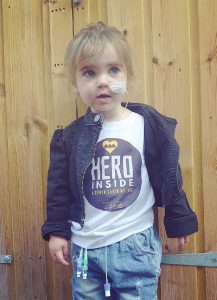In July 2022, we told the story of 16-month-old Beatrix Archbold, who was awaiting a heart transplant with her parents Terry and Cheryl being supported at our Scott House ‘Home from Home’. After a 14 month stay, we are thrilled to report that Beatrix has received her donor heart and is finally back home. This Organ Donation Week, dad Terry brings us up to speed on Bea’s journey and explains why their desire to raise awareness about child organ donation remains as strong as ever.

Dad Terry with Beatrix in 2022. Credit: Terry Archbold.
In June of this year, we finally received news that a donor heart had been found for Bea. She’d been at Newcastle’s Freeman Hospital since May 2022 after suffering heart failure, being fitted with a Berlin Ventricular Assist Device, which is an air driven pump that takes over the work of one side of the heart while the other continues to work naturally. It ended up being in place for 14 long months.
From the point we were told the transplant was happening, time rapidly accelerated. It started a completely new cycle of things for us to worry about. There was a 10-15 percent chance of death from the surgery itself, never mind everything that can go wrong afterwards.
Bea made it through the surgery, but to give her new heart the best chance of recovering, she was intubated and kept asleep for ten days. While there are lots of risks, this was her only chance. The reality for kids on Berlin hearts is the longer the wait for a transplant, the higher the risk of dying from something else, like a stroke or an infection. Despite the long wait, thankfully everything fell into place for her.
In the weeks that followed we stayed in Scott House’s transplant flat, which proved so important. Bea essentially lived there with us for a week, allowing us time to figure out how to manage her medication and everything else while still being just moments away from The Freeman. It is a wonderful resource, a stepping-stone for getting used to looking after Bea without medical equipment, but being close enough to the hospital should anything go wrong.

Beatrix modelling a t-shirt raising awareness about her own donor heart. Credit: Terry Archbold.
It’s a bit weird being home after spending so long away. Even now, a few weeks down the line, we find ourselves going into Bea’s bedroom to check that she is actually here. In one respect it is a relief that we are not at The Freeman anymore, but it has been hard getting used to not having the safety net of the medical staff and equipment. But honestly, it is just wonderful to have her home after such a long time.
I’m so pleased to say that she is doing great. It has been a big adjustment for her, especially learning to walk without being connected to the Berlin heart. There was always a metre of pipework connecting her to the machine, so she’s never been able to walk properly. She’s had to re-learn how to walk without being connected to a machine. She ran for the first time ever the other day, in the rain! It sounds a simple thing, but she was on the ward for over a year and had never experienced it before. Even things like walking up a few stairs, something easily taken for granted, is completely new and amazing for her.
She misses the nurses and staff at The Freeman. They were like her family, as were the other kids on the ward and their families. You cannot go through such traumatic experiences with those people without forming a strong, deep bond. It has been strange adjusting to that. When we go back to The Freeman for her weekly transplant clinic, we always pop into the ward so Bea can say hello. This is important not only for us and Bea, but also the kids who are still on the High Dependency Unit (HDU) who Bea became friends with. There is a lot of emotional trauma for the kids and the parents along this kind of journey.

Bea with the Tin Man from The Wizard of Oz, who famously went in search of a heart. Credit: Terry Archbold.
The bond between the families is special, and we are still in touch with the bulk of them. Obviously, we are all in very similar situations, so you naturally support each other. Scott House is a fantastic place that does so much to support the transplant families at The Freeman, and we are so grateful that it was there for us for over a year, free of charge. It’s hard to appreciate just how valuable a resource Scott House is to transplant families. We’ll never be able to repay The Sick Children’s Trust for what they have done for us.
In terms of child organ donation, I don’t think we’ll ever stop talking about it. It comes from when we lost our daughter Isabel, who was stillborn in 2018, and how it felt to be asked about donating her organs at such an emotional and traumatic time. Bea’s situation has giving us even more reason to shout from the rooftops about it. Having donated Isabel’s organs and with Bea receiving a donor heart, we are in a relatively unique position to talk about the power of giving and receiving organs. Until the donor consent levels go up, both for children and adults, we are going to keep doing our best to raise awareness about this.
We understand that conversations around donating a child’s organs are not easy, but it is so important. The lives of so many kids out there can be saved by doing it. We owe it to Bea’s donor to highlight just how important this is, showing the power of organ donation and how Bea’s life will continue because of it.
Terry Archbold, Beatrix’s dad.
